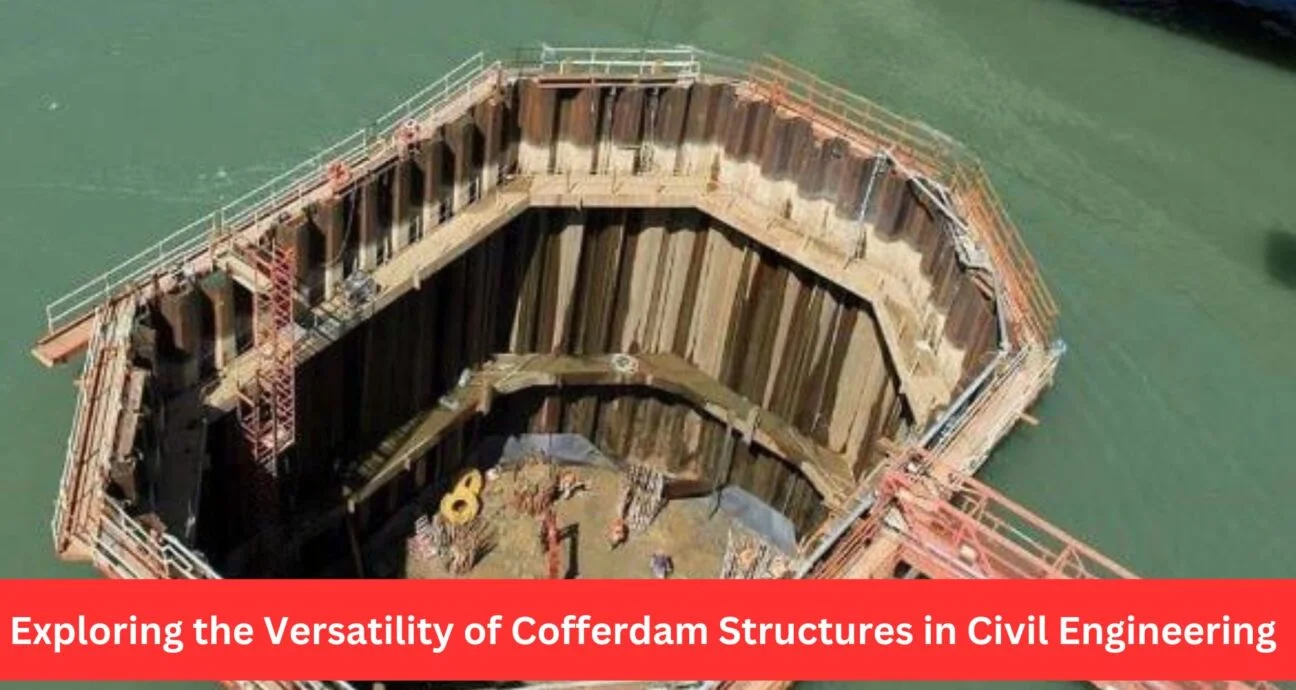Civil engineering is a diverse field that encompasses various innovative techniques and structures to tackle complex challenges in construction. One such versatile structure widely used in civil engineering projects is the cofferdam. Cofferdams are temporary structures designed to create a dry work environment in watery areas, allowing construction activities to take place efficiently. In this article, we will delve into the world of cofferdam structures, exploring their versatility, benefits, and applications in civil engineering projects.
1. Introduction
In civil engineering, projects involving water bodies such as rivers, lakes, and oceans present unique challenges. To overcome these challenges, engineers have developed cofferdam structures, which offer an effective solution for creating a dry work environment in waterlogged areas. Cofferdams have proven to be highly versatile and find applications in various types of construction projects.
2. What is a Cofferdam?
A cofferdam is a temporary enclosure or barrier constructed in or around water bodies to facilitate construction activities. It enables engineers to create a dry working area by preventing water from entering the construction site. Typically, cofferdams are constructed using sheet piles, concrete walls, or a combination of both.
3. Types of Cofferdams
There are several types of cofferdams used in civil engineering, depending on the project requirements and site conditions. Some common types include:
a. Cellular Cofferdams
Cellular cofferdams are constructed using interconnected cells or compartments. These cells are filled with soil or concrete to provide stability. They are often used in large-scale projects where the water depths are significant.
b. Braced Cofferdams
Braced cofferdams use a framework of vertical or inclined steel members to provide structural stability. They are suitable for projects with moderate water depths and offer flexibility during construction.
c. Rockfill Cofferdams
Rockfill cofferdams are constructed by placing large rocks or stones in a specific arrangement to form a barrier. They are commonly used when the available soil is not suitable for construction.
d. Earthfill Cofferdams
Earthfill cofferdams utilize compacted soil or clay to create a barrier. They are cost-effective and easy to construct, making them suitable for small to medium-scale projects.
4. Components of a Cofferdam
A typical cofferdam consists of several essential components, including:
a. Sheet Piles
Sheet piles are long, interlocking steel or concrete sections driven vertically into the ground to form a continuous barrier. They provide structural support and prevent water from seeping into the construction site.
b. Waling Beams
Waling beams are horizontal support members connected to the sheet piles. They distribute the load and provide stability to the cofferdam structure.
c. Tie Rods
Tie rods are used to reinforce the cofferdam by connecting the sheet piles and waling beams. They add strength and rigidity to the structure, ensuring its stability during construction.
d. Bracing Systems
Bracing systems, such as struts or braces, are installed to further enhance the stability of the cofferdam. These components resist lateral forces and maintain the structural integrity of the enclosure.
e. Water Sealing Elements
Water sealing elements, such as seals or grouting, are utilized to prevent water from seeping through gaps between the sheet piles or other components. This ensures a watertight construction environment.
5. Construction Process
The construction process of a cofferdam involves several steps:
Site Assessment: A thorough evaluation of the site conditions, including water depth, soil type, and potential risks, is conducted to determine the most suitable type of cofferdam.
Design and Planning: Engineers design the cofferdam structure based on the project requirements and site conditions. Factors such as load capacity, stability, and water pressure are carefully considered.
Sheet Pile Installation: Sheet piles are driven into the ground using specialized equipment. Interlocking sections create a continuous barrier, preventing water from seeping into the construction area.
Excavation: Once the sheet piles are in place, the area within the cofferdam is excavated to create a dry working space. Excavated materials may be temporarily stored or transported off-site.
Dewatering: Water inside the cofferdam is pumped out, maintaining a dry environment for construction activities. Depending on the project duration, dewatering systems may be installed and monitored throughout the construction phase.
Construction Activities: With the work area now dry, construction activities such as foundation laying, structural assembly, or repairs can take place efficiently and safely.
Completion and Demobilization: Once the construction work is finished, the cofferdam is disassembled, and the site is restored to its original state. Materials are properly disposed of or recycled as per environmental regulations.
6. Applications of Cofferdams
Cofferdams find diverse applications in civil engineering projects. Some common applications include:
a. Bridge Construction and Repair
During bridge construction or repair, cofferdams are used to create a dry work area around the piers or abutments. This allows for the construction of foundations, repair of substructures, or installation of underwater supports.
b. Dam Construction and Maintenance
In dam construction and maintenance projects, cofferdams are employed to create a dry work environment around the dam site. This facilitates activities such as foundation preparation, construction of intake structures, or repair of spillways.
c. Pipeline Installation and Repair
Cofferdams are utilized in pipeline projects to provide a dry workspace for installing or repairing underwater pipelines. This ensures accurate alignment, proper welding, and efficient maintenance.
d. Harbor and Port Development
For the construction or expansion of harbors and ports, cofferdams are used to create temporary dry docks. This enables the construction of marine structures, such as piers, docks, or breakwaters, without the need for expensive permanent structures.
e. Water Treatment Facilities
Cofferdams play a crucial role in the construction and maintenance of water treatment facilities. They allow for the construction of intake structures, discharge channels, or treatment tanks in water bodies, ensuring a controlled and dry working environment.
f. Flood Control and Embankment Construction
In flood-prone areas, cofferdams can be used as temporary barriers to divert or control water flow during construction or emergency situations. They are also employed in embankment construction to create a dry work area for soil compaction and stability.
g. Underwater Inspections and Repairs
Cofferdams provide a controlled and dry space for conducting underwater inspections and repairs. This is particularly useful in situations where traditional diving methods may be challenging or impractical.
7. Advantages of Using Cofferdams
The use of cofferdams in civil engineering projects offers several advantages:
a. Safety and Efficiency
Cofferdams provide a safe and controlled working environment by keeping water out of the construction area. This enhances the efficiency of construction activities and minimizes the risk of accidents or damage to equipment.
b. Flexibility and Adaptability
Cofferdams can be customized to suit different project requirements, site conditions, and water depths. They offer flexibility in terms of size, shape, and materials, allowing engineers to adapt the structure to specific project needs.
c. Cost-effectiveness
Compared to alternative methods of dewatering or underwater construction, cofferdams are often a cost-effective solution. They eliminate the need for complex pumping systems or specialized underwater construction equipment, resulting in reduced project costs.
d. Environmental Protection
Cofferdams help in mitigating potential environmental impacts during construction activities. They prevent the release of sediment, pollutants, or construction debris into water bodies, ensuring minimal disturbance to aquatic ecosystems.
e. Reusability
Many cofferdam components, such as sheet piles and tie rods, can be disassembled and reused in multiple projects. This not only reduces material waste but also offers cost savings for future construction endeavors.
8. Environmental Considerations
While cofferdams provide numerous benefits, it is crucial to consider their environmental impact. Engineers and project managers should adhere to environmental regulations and implement measures to minimize ecological disruption. Some key considerations include:
a. Sediment and Water Quality Management
Efficient sediment and water quality management systems should be in place to prevent the release of sediments, chemicals, or pollutants into the surrounding water bodies during cofferdam construction and dewatering processes.
b. Habitat Protection
Special care should be taken to minimize disturbance to aquatic habitats near the cofferdam site. Measures such as installing fish screens or implementing fish relocation programs can help protect aquatic species during construction activities.
c. Erosion and Bank Stabilization
Cofferdams may temporarily alter water flow patterns, leading to erosion or destabilization of riverbanks. Proper erosion control measures, such as the use of erosion control blankets or vegetation, should be implemented to prevent soil erosion and maintain bank stability.
d. Noise and Vibration Management
Construction activities associated with cofferdams can generate noise and vibration that may affect aquatic life. Mitigation measures, such as using noise barriers or scheduling work during periods of low biological activity, should be employed to minimize these impacts.
e. Monitoring and Compliance
Regular monitoring of water quality, sediment discharge, and impact on aquatic ecosystems should be conducted throughout the cofferdam construction and dewatering process. This ensures compliance with environmental regulations and allows for timely corrective actions if needed.
In conclusion, cofferdams are versatile structures that play a crucial role in various civil engineering projects. Their applications range from bridge construction and dam maintenance to pipeline installation and harbor development. By providing a safe and dry working environment, cofferdams enhance construction efficiency while minimizing environmental impacts. Proper planning, design, and adherence to environmental regulations are essential to ensure the successful and sustainable use of cofferdams in civil engineering projects.
Learn more about our sheet piles services across Malaysia
Author

Chee How is a seasoned professional in the construction and civil engineering industry with over 11 years of experience. Specializing in sheet piling solutions, Chee How brings a wealth of knowledge on sustainable building practices, innovative engineering techniques, and industry trends. As a dedicated expert at Hai Fu Sheet Piles Sdn Bhd, Chee How is committed to providing practical insights and expert advice to help professionals achieve their project goals with efficiency and precision. Outside of work, Chee How enjoys reading and basketball, reflecting a passion for both professional and personal growth.
View all posts


